Estimation of Ultrahigh Resolution PM2.5 Mass Concentrations Based on Mie Scattering Theory by Using Landsat8 OLI Images over Pearl River Delta
Abstract
1. Introduction
2. Materials and Methods
2.1. Study Area and Datasets
2.2. Methods
2.2.1. AOD Retrieval Algorithm
2.2.2. Aerosol Model Determination
2.2.3. Multiband AOD Retrieval
2.2.4. PM2.5-AOD Model Building
2.2.5. Volume Distribution Solution
2.2.6. Model Evaluation
3. Results
3.1. Retrieved Results from the Proposed Model
3.2. Comparison of Landsat8 OLI AOD with MODO4 DB AOD
3.3. Comparison Landsat8 OLI PM2.5 with Ground Measurements
3.4. Error Estimation
4. Discussion
5. Conclusions
Author Contributions
Funding
Acknowledgments
Conflicts of Interest
References
- Dockery, D.W.; Pope, C.A. Acute respiratory effects of particulate air pollution. Annu. Rev. Public Health 1994, 15, 107. [Google Scholar] [CrossRef]
- Beelen, R.; Raaschou-Nielsen, O.; Stafoggia, M.; Andersen, Z.J.; Weinmayr, G.; Hoffmann, B.; Wolf, K.; Samoli, E.; Fischer, P.; Nieuwenhuijsen, M.; et al. Effects of long-term exposure to air pollution on natural-cause mortality: An analysis of 22 Europeanm cohorts within the multicentre ESCAPE project. Lancet 2014, 383, 785–795. [Google Scholar] [CrossRef]
- Dockery, D.W.; Xu, X.; Spengler, J.D.; Ware, J.H.; Fay, M.E.; Ferris, B., Jr.; Speizer, F.E. An association between air pollution and mortality in six U.S. cities. N. Engl. J. Med. 2013, 329, 1753–1759. [Google Scholar] [CrossRef] [PubMed]
- Pope, C.A., III; Burnett, R.T.; Thun, M.J.; Calle, E.E.; Krewski, D.; Ito, K.; Thurston, G.D. Lung Cancer, Cardiopulmonary Mortality, and Long-term Exposure to Fine Particulate Air Pollution. JAMA 2002, 287, 1132–1141. [Google Scholar] [CrossRef]
- Li, C.; Hsu, N.C.; Tsay, S.C. A study on the potential applications of satellite data in air quality monitoring and forecasting. Atmos. Environ. 2011, 45, 3663–3675. [Google Scholar] [CrossRef]
- Van, D.A.; Martin, R.V.; Spurr, R.J.; Burnett, R.T. High-resolution satellite-derived PM2.5 from optimal estimation and geographically weighted regression over North America. Environ. Sci. Technol. 2015, 49, 10482–10491. [Google Scholar] [CrossRef]
- Che, H.; Xia, X.; Zhu, J.; Li, Z.; Dubovik, O.; Holben, B.; Goloub, P.; Chen, H.; Estelles, V.; Cuevas-Agulló, E. Column aerosol optical properties and aerosol radiative forcing during a serious haze-fog month over North China Plain in 2013 based on ground-based sunphotometer measurements. Atmos. Chem. Phys. 2014, 14, 2125–2138. [Google Scholar] [CrossRef]
- Gupta, P.; Christopher, S.A. Seven year particulate matter air quality assessment from surface and satellite measurements. Atmos. Chem. Phys. 2008, 8. [Google Scholar] [CrossRef]
- Lin, T.H. To construct an effective coefficient of aerosol size distribution for atmospheric turbidity retrieval. Terr. Atmos. Ocean. 2005, 16, 691–706. [Google Scholar] [CrossRef][Green Version]
- Janet, N.; Muhammad, B. Validation of MODIS 3 km Resolution Aerosol Optical Depth Retrievals Over Asia. Remote Sens. 2016, 8, 328. [Google Scholar] [CrossRef]
- Sun, K.; Chen, X.; Zhu, Z.; Zhang, T. High Resolution Aerosol Optical Depth Retrieval Using Gaofen-1 WFV Camera Data. Remote Sens. 2017, 9, 89. [Google Scholar] [CrossRef]
- Omari, K.; Abuelgasim, A.; Alhebsi, K. Aerosol optical depth retrieval over the city of Abu Dhabi, United Arab Emirates (UAE) using Landsat-8 OLI images. Atmos. Pollut. Res. 2019, 10, 1075–1083. [Google Scholar] [CrossRef]
- Paciorek, C.J.; Liu, Y. Limitations of Remotely Sensed Aerosol as a Spatial Proxy for Fine Particulate Matter. Environ. Health Perspect. 2009, 117, 904–909. [Google Scholar] [CrossRef]
- Liu, Y.; Sarnat, J.A.; Kilaru, V.; Jacob, D.J.; Koutrakis, P. Estimating ground-level PM2.5 in the eastern United States using satellite remote sensing. Environ. Sci. Technol. 2005, 39, 3269–3278. [Google Scholar] [CrossRef] [PubMed]
- Gupta, P.; Christopher, S.A.; Wang, J.; Gehrig, R.; Lee, Y.; Kumar, N. Satellite remote sensing of particulate matter and air quality assessment over global cities. Atmos. Environ. 2006, 40, 5880–5892. [Google Scholar] [CrossRef]
- Gupta, P.; Christopher, S.A. Particulate matter air quality assessment using integrated surface, satellite, and meteorological products: Multiple regression approach. J. Geophys. Res. Atmos. 2009, 114. [Google Scholar] [CrossRef]
- Engel-Cox, J.A.; Holloman, C.H.; Coutant, B.W.; Hoff, R.M. Qualitative and quantitative evaluation of MODIS satellite sensor data for regional and urban scale air quality. Atmos. Environ. 2004, 38, 2495–2509. [Google Scholar] [CrossRef]
- Kloog, I.; Koutrakis, P.; Coull, B.A.; Lee, H.J.; Schwartz, J. Assessing temporally and spatially resolved PM2.5 exposures for epidemiological studies using satellite aerosol optical depth measurements. Atmos. Environ. 2011, 45, 6267–6275. [Google Scholar] [CrossRef]
- Paciorek, C.J.; Liu, Y.; Moreno-Macias, H.; Kondragunta, S. Spatiotemporal associations between GOES aerosol optical depth retrievals and ground-level PM2.5. Environ. Sci. Technol. 2008, 42, 5800–5806. [Google Scholar] [CrossRef] [PubMed]
- Schaap, M.; Apituley, A.; Timmermans, R.M.A.; Koelemeijer, R.B.A.; de Leeuw, G. Exploring the relation between aerosol optical depth and PM2.5 at Cabauw, the Netherlands. Atmos. Chem. Phys. 2008, 9, 909–925. [Google Scholar] [CrossRef]
- Liu, Y.; Paciorek, C.J.; Koutrakis, P. Estimating regional spatial and temporalvariability of PM2.5 mass concentration using satellite data, meteorology, and land useinformation. Environ. Health Perspect. 2019, 117, 886–892. [Google Scholar] [CrossRef]
- Emili, E.; Popp, C.; Petitta, M.; Riffler, M.; Wunderle, S.; Zebisch, M. PM10 remote sensing from geostationary SEVIRI and polar-orbiting MODIS sensors over the complex terrain of the European Alpine region. Remote Sens. Environ. 2010, 114, 2485–2499. [Google Scholar] [CrossRef]
- Kloog, I.; Nordio, F.; Coull, B.A.; Schwartz, J. Incorporating local land use regression and satellite aerosol optical depth in a hybrid model of spatiotemporal PM2.5 exposures in the mid-Atlantic states. Environ. Sci. Technol. 2012, 46, 11913–11921. [Google Scholar] [CrossRef]
- Xu, J.; Schüssler, O.; Rodriguez, D.G.L.; Romahn, F.; Doicu, A. A Novel Ozone Profile Shape Retrieval Using Full-Physics Inverse Learning Machine (FP-ILM). IEEE J. Sel. Top. Appl. Earth Obs. Remote Sens. 2017, 10, 5442–5457. [Google Scholar] [CrossRef]
- Hong, D.; Yokoya, N.; Xu, J.; Zhu, X. Joint progressive learning from high-dimensional data for multi-label classification. In Proceedings of the European Conference on Computer Vision (ECCV), Munich, Germany, 8–14 September 2018; pp. 469–484. [Google Scholar] [CrossRef]
- Van Donkelaar, A.; Martin, R.V.; Brauer, M.; Kahn, R.; Levy, R.; Verduzco, C.; Villeneuve, P.J. Global estimates of ambient fine particulate matter concentrations from satellite-based aerosol optical depth: Development and application. Environ. Health Perspect. 2010, 118, 847–855. [Google Scholar] [CrossRef] [PubMed]
- Wang, J.; Xu, X.; Spurr, R.; Wang, Y.; Drury, E. Improved algorithm for MODIS satellite retrievals of aerosol optical thickness over land in dusty atmosphere: Implications for air quality monitoring in China. Remote Sens. Environ. 2010, 114, 2575–2583. [Google Scholar] [CrossRef]
- Xu, X.; Wang, J.; Henze, D.K.; Qu, W.; Kopacz, M. Constraints on aerosol sources using GEOS-Chem adjoint and MODIS radiances, and evaluation with multisensor (OMI, MISR) data. J. Geophys. Res. Atmos. 2013, 118, 6396–6413. [Google Scholar] [CrossRef]
- Zhang, Y.; Li, Z. Remote sensing of atmospheric fine particulate matter (PM2.5) mass concentration near the ground from satellite observation. Remote Sens. Environ. 2015, 160, 252–262. [Google Scholar] [CrossRef]
- Lee, H.; Liu, Y.; Coull, B.; Schwartz, J.; Koutrakis, P. A novel calibration approach of MODIS AOD data to predict PM2.5 concentrations. Atmos. Chem. Phys. 2011, 11, 9769–9795. [Google Scholar] [CrossRef]
- Chang, H.H.; Hu, X.; Liu, Y. Calibrating MODIS aerosol optical depth for predicting daily PM2.5 concentrations via statistical downscaling. J. Expo. Sci. Environ. Epidemiol. 2014, 24, 398–404. [Google Scholar] [CrossRef] [PubMed]
- Oo, M.; Ross, A.; Holz, R.; Holloway, T.; Ackerman, S. Investigating cloud contamination in MODIS and VIIRS AOD retrievals and the impacts on air quality applications. AGU Fall Meet. Abstr. 2013, A43D-0296. [Google Scholar]
- Wu, J.; Yao, F.; Li, W.; Si, M. VIIRS-based remote sensing estimation of ground-level PM2.5 concentrations in Beijing–Tianjin–Hebei: A spatiotemporal statistical model. Remote Sens. Environ. 2016, 184, 316–328. [Google Scholar] [CrossRef]
- Liu, Y.; Franklin, M.; Kahn, R.; Koutrakis, P. Using aerosol optical thickness to predict ground-level PM2.5 concentrations in the St. Louis area: A comparison between MISR and MODIS. Remote Sens. Environ. 2007, 107, 33–44. [Google Scholar] [CrossRef]
- Lu, X.; Chen, Y.; Huang, Y.; Lin, C.; Li, Z.; Fung, J.C.; Lau, A.K. Differences in concentration and source apportionment of PM2.5 between 2006 and 2015 over the PRD region in southern China. Sci. Total Environ. 2019, 673, 708–718. [Google Scholar] [CrossRef] [PubMed]
- Wu, Z.; Zhang, Y.; Zhang, L.; Huang, M.; Zhong, L.; Chen, D.; Wang, X. Trends of outdoor air pollution and the impact on premature mortality in the Pearl River Delta region of southern China during 2006–2015. Sci. Total Environ. 2019, 690, 248–260. [Google Scholar] [CrossRef] [PubMed]
- Vermote, E.F.; Tanré, D.; Deuze, J.L.; Herman, M.; Morcette, J. Second simulation of the satellite signal in the solar spectrum, 6S: An overview. IEEE Trans. Geosci. Remote Sens. 1997, 35, 675–686. [Google Scholar] [CrossRef]
- Li, Z.; Niu, F.; Lee, K.; Xin, J.; Hao, W.; Nordgren, B.; Wang, Y.; Wang, P. Validation and understanding of Moderate Resolution Imaging Spectroradiometer aerosol products (C5) using ground-based measurements from the handheld Sun photometer network in China. J. Geophys. Res. Atmos. 2007, 112. [Google Scholar] [CrossRef]
- Wurl, D.; Grainger, R.; McDonald, A.; Deshler, T. Optimal estimation retrieval of aerosol microphysical properties from SAGE II satellite observations in the lower stratosphere. Atmos. Chem. Phys. 2010, 10, 4295–4317. [Google Scholar] [CrossRef]
- Yang, Y.-J.; Fu, Y.-F.; Wu, B.-W.; Shi, C.; Deng, X.-L.; Zhang, H.; Zhang, Y. Impacts of Agricultural Fire on Aerosol Distribution over East China During Summer Harvest Time. J. Atmos. Environ. Opt. 2013, 8, 5–16. [Google Scholar] [CrossRef]
- Angstrom, A. Techniques of Determinig the Turbidity of the Atmosphere. Tellus B 1961, 13. [Google Scholar] [CrossRef]
- Busen, R.; Hänel, G. Radiation budget of the boundary layer, Part1: Measurement of absorption of solar radiation by atmospheric particles and water vapour. Beitraege Zur Phys. Der Atmos. 1987, 60, 229–240. [Google Scholar]
- Lin, C.; Li, Y.; Yuan, Z.; Lau, A.K.; Li, C.; Fung, J.C. Using satellite remote sensing data to estimate the high-resolution distribution of ground-level PM2.5. Remote Sens. Environ. 2015, 156, 117–128. [Google Scholar] [CrossRef]
- Koelemeijer, R.B.A.; Homan, C.D.; Matthijsen, J. Comparison of spatial and temporal variations of aerosol optical thickness and particulate matter over Europe. Atmos. Environ. 2006, 40, 5304–5315. [Google Scholar] [CrossRef]
- Kasten, F. Visibility forecast in the phase of pre-condensation. Tellus 1969, 21, 631–635. [Google Scholar] [CrossRef]
- Tang, I.N. Chemical and size effects of hygroscopic aerosols on light scattering coefficients. J. Geophys. Res. Atmos. 1996, 101, 19245–19250. [Google Scholar] [CrossRef]
- Tang, I.N.; Munkelwitz, H.R. Water activities, densities, and refractive indices of aqueous sulfates and sodium nitrate droplets of atmospheric importance. J. Geophys. Res. Atmos. 1994, 99, 18801. [Google Scholar] [CrossRef]
- Liu, X.; Cheng, Y.; Zhang, Y.; Jung, J.; Sugimoto, N.; Chang, S.-Y.; Kim, Y.J.; Fan, S.; Zeng, L. Influences of relative humidity and particle chemical composition on aerosol scattering properties during the 2006 PRD campaign. Atmos. Environ. 2008, 42, 1525–1536. [Google Scholar] [CrossRef]
- Holben, B.N.; Eck, T.F.; Slutsker, I.a.; Tanre, D.; Buis, J.; Setzer, A.; Vermote, E.; Reagan, J.A.; Kaufman, Y.; Nakajima, T.; et al. AERONET—A Federated Instrument Network and Data Archive for Aerosol Characterization. Remote Sens. Environ. 1998, 66, 1–16. [Google Scholar] [CrossRef]
- Lee, A.K.Y.; Ling, T.Y.; Chan, C.K. Understanding hygroscopic growth and phase transformation of aerosols using single particle Raman spectroscopy in an electrodynamic balance. Faraday Discuss. 2008, 137, 245–263. [Google Scholar] [CrossRef] [PubMed]
- Yamamoto, G.; Tanaka, M. Determination of aerosol size distribution from spectral attenuation measurements. Appl. Opt. 1969, 8, 447–453. [Google Scholar] [CrossRef]
- Nussenzveig, H.M.; Wiscombe, W.J. Efficiency Factors in Mie Scattering. Phys. Rev. Lett. 1980, 45, 1490–1494. [Google Scholar] [CrossRef]
- Bassan, P.; Kohler, A.; Martens, H.; Lee, J.; Byrne, H.J.; Dumas, P.; Gazi, E.; Brown, M.; Clarke, N.; Gardner, P. Resonant Mie Scattering (RMieS) correction of infrared spectra from highly scattering biological samples. Analyst 2010, 135, 268–277. [Google Scholar] [CrossRef] [PubMed]
- Shaw, G.E. On the Aerosol Particle Size Distribution Spectrum in Alaskan Air Mass Systems: Arctic Haze and Non-Haze Episodes. J. Atmos. Sci. 1983, 40, 1313–1320. [Google Scholar] [CrossRef]
- Liou, K.N. An Introduction to Atmospheric Radiation; Academic Press: Cambridge, MA, USA, 2002. [Google Scholar] [CrossRef]
- Hulst, H.C.; van de Hulst, H.C. Light scattering by small particles. Phys. Today 1957, 10. [Google Scholar] [CrossRef]
- Gao, J.; Zhou, Y.; Wang, J.; Wang, T.; Wang, W.X. Inter-comparison of WPSTM-TEOMTM-MOUDITM and investigation on particle density. Environ. Sci. 2007, 28, 1929–1934. [Google Scholar] [CrossRef]
- Rummelhart, D.E.; Hinton, G.E.; Williams, R.J. Learning internal representations by error propagation. Read. Cogn. Sci. 1988, 323, 399–421. [Google Scholar]
- Wang, Y.; Chirikjian, G.S. Second-Order Theory of Error Propagation on Motion Groups. Int. J. Robot. Res. 2006. [Google Scholar] [CrossRef]
- Kwiecień, J.; Szopińska, K. Mapping Carbon Monoxide Pollution of Residential Areas in a Polish City. Remote Sens. 2020, 12, 2885. [Google Scholar] [CrossRef]
- Forehead, H.; Huynh, N. Review of modelling air pollution from traffic at street-level—The state of the science. Environ. Pollut. 2018, 241, 775–786. [Google Scholar] [CrossRef] [PubMed]
- Tsanakas, N. Emission Estimation Based on Traffic Models and Measurements; LiU Tryck: Linköping, Sweden, 2019; pp. 80–85. [Google Scholar]
- Tsai, T.-C.; Jeng, Y.-J.; Chu, D.A.; Chen, J.-P.; Chang, S.-C. Analysis of the relationship between MODIS aerosol optical depth and particulate matter from 2006 to 2008. Atmos. Environ. 2011, 45, 4777–4788. [Google Scholar] [CrossRef]
- Tanré, D.; Bréon, F.; Deuzé, J.; Dubovik, O.; Ducos, F.; François, P.; Goloub, P.; Herman, M.; Lifermann, A.; Waquet, F. Remote sensing of aerosols by using polarized, directional and spectral measurements within the A-Train: The PARASOL mission. Atmos. Meas. Tech. 2011, 4, 1383–1395. [Google Scholar] [CrossRef]
- Hollstein, A.; Fischer, J. Retrieving aerosol height from the oxygen A band: A fast forward operator and sensitivity study concerning spectral resolution, instrumental noise, and surface inhomogeneity. Atmos. Meas. Tech. Discuss. 2013, 6. [Google Scholar] [CrossRef]
- Chu, D.A.; Tsai, T.-C.; Chen, J.-P.; Chang, S.-C.; Jeng, Y.-J.; Chiang, W.-L.; Lin, N.-H. Interpreting aerosol lidar profiles to better estimate surface PM2.5 for columnar AOD measurements. Atmos. Environ. 2013, 79, 172–187. [Google Scholar] [CrossRef]
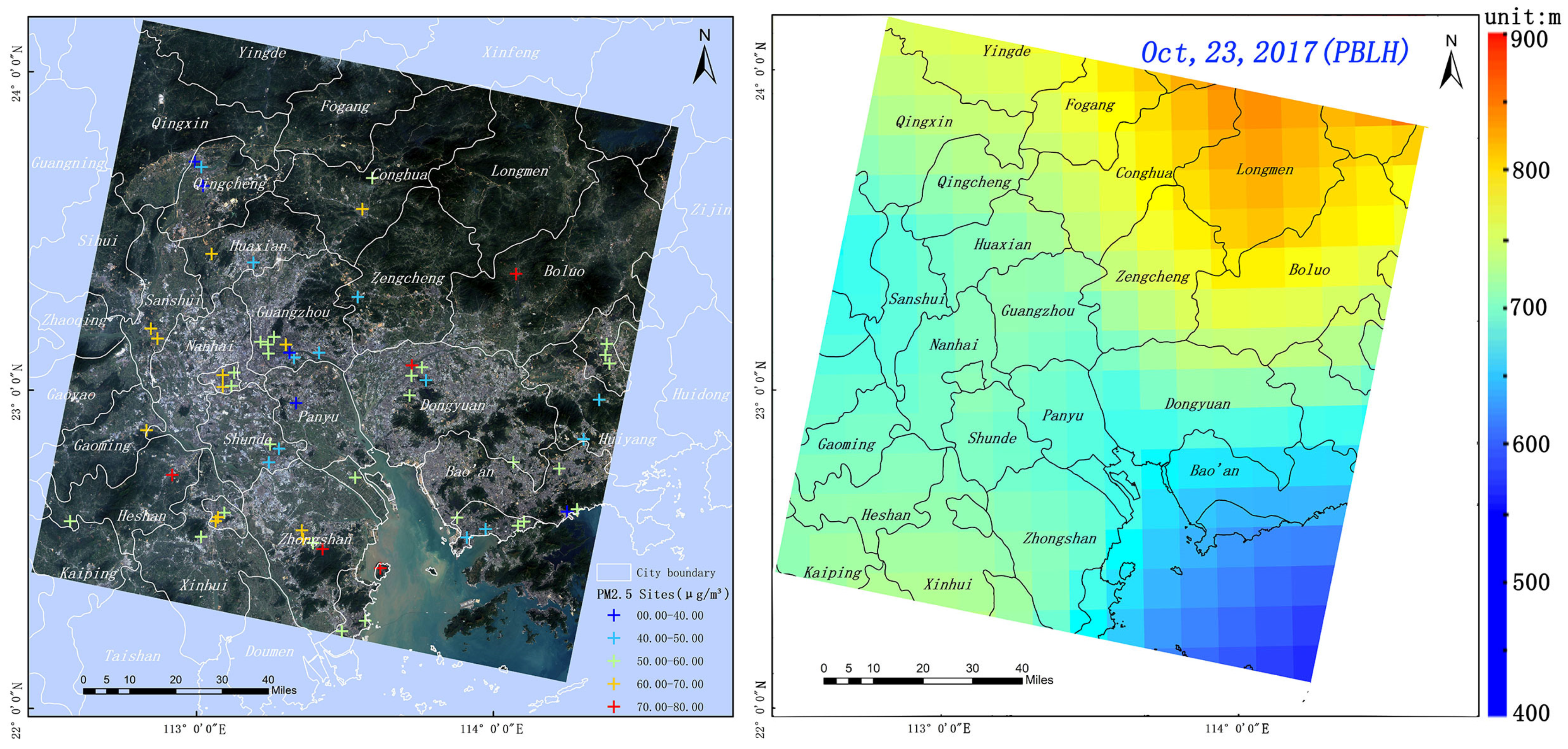


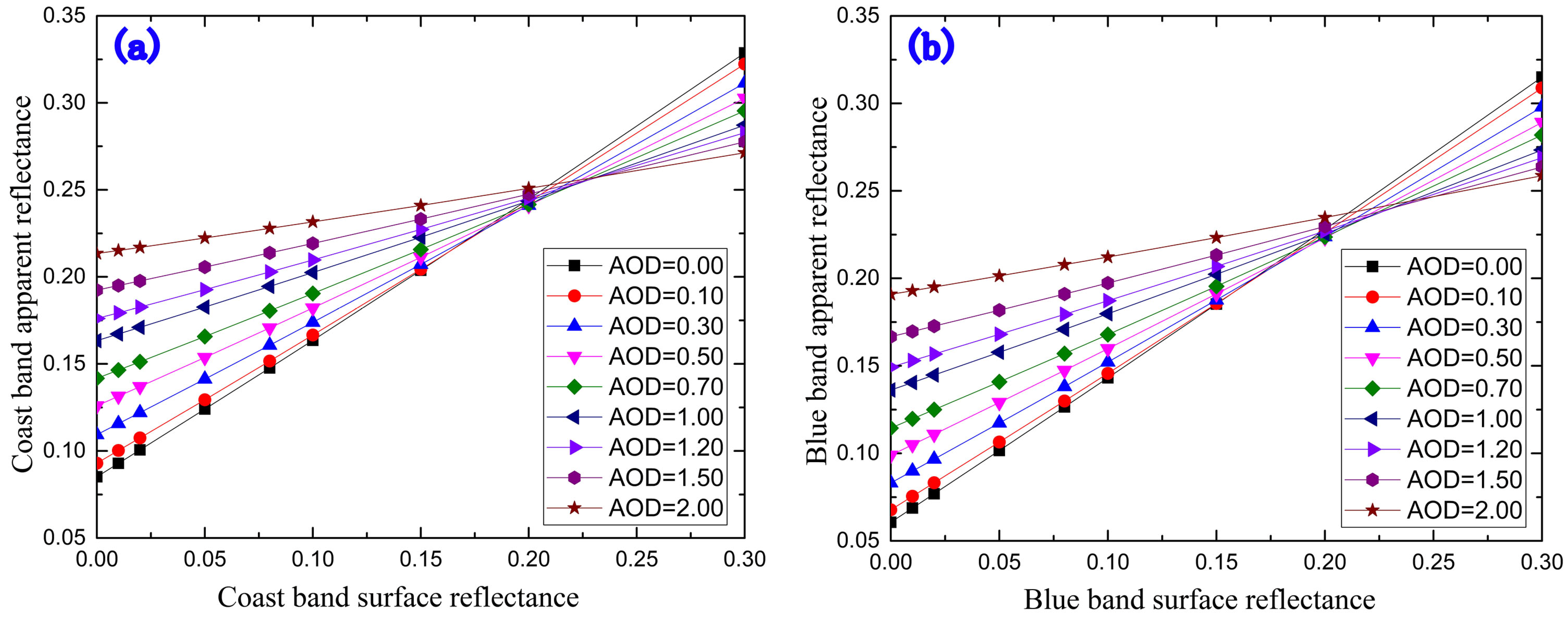
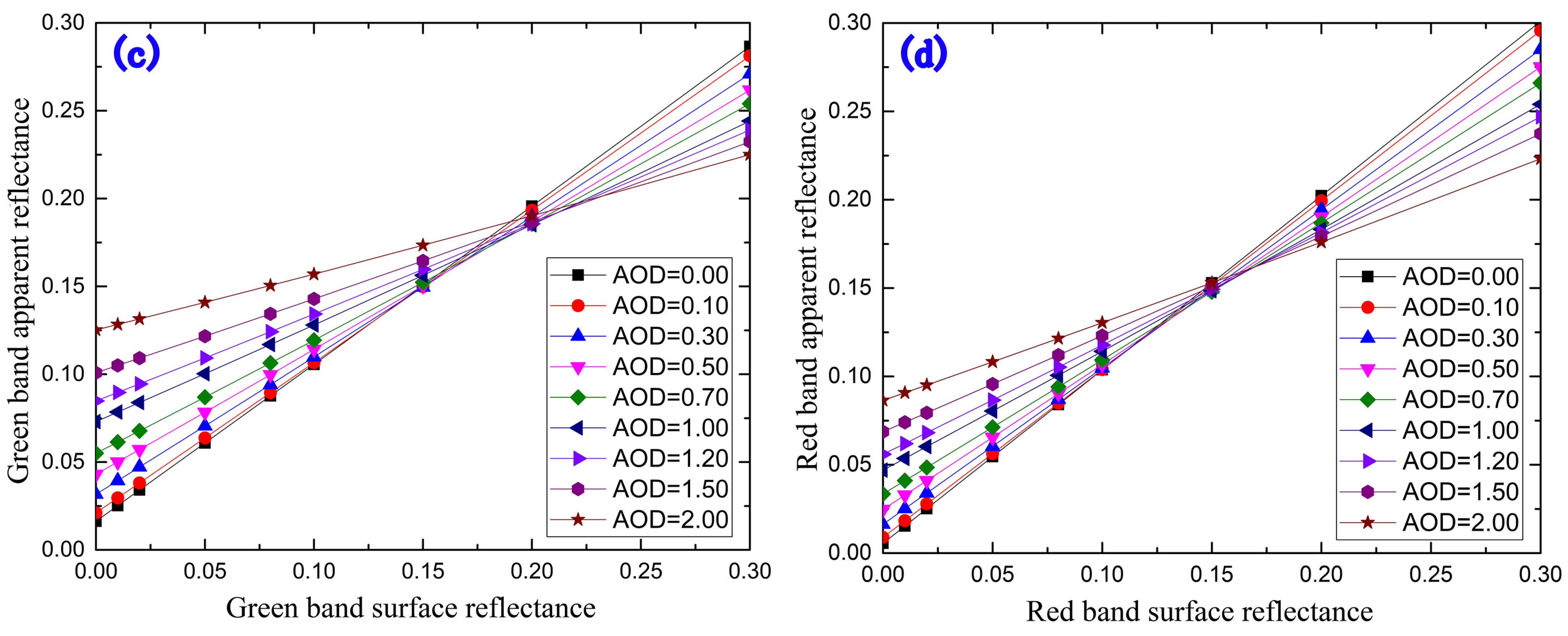



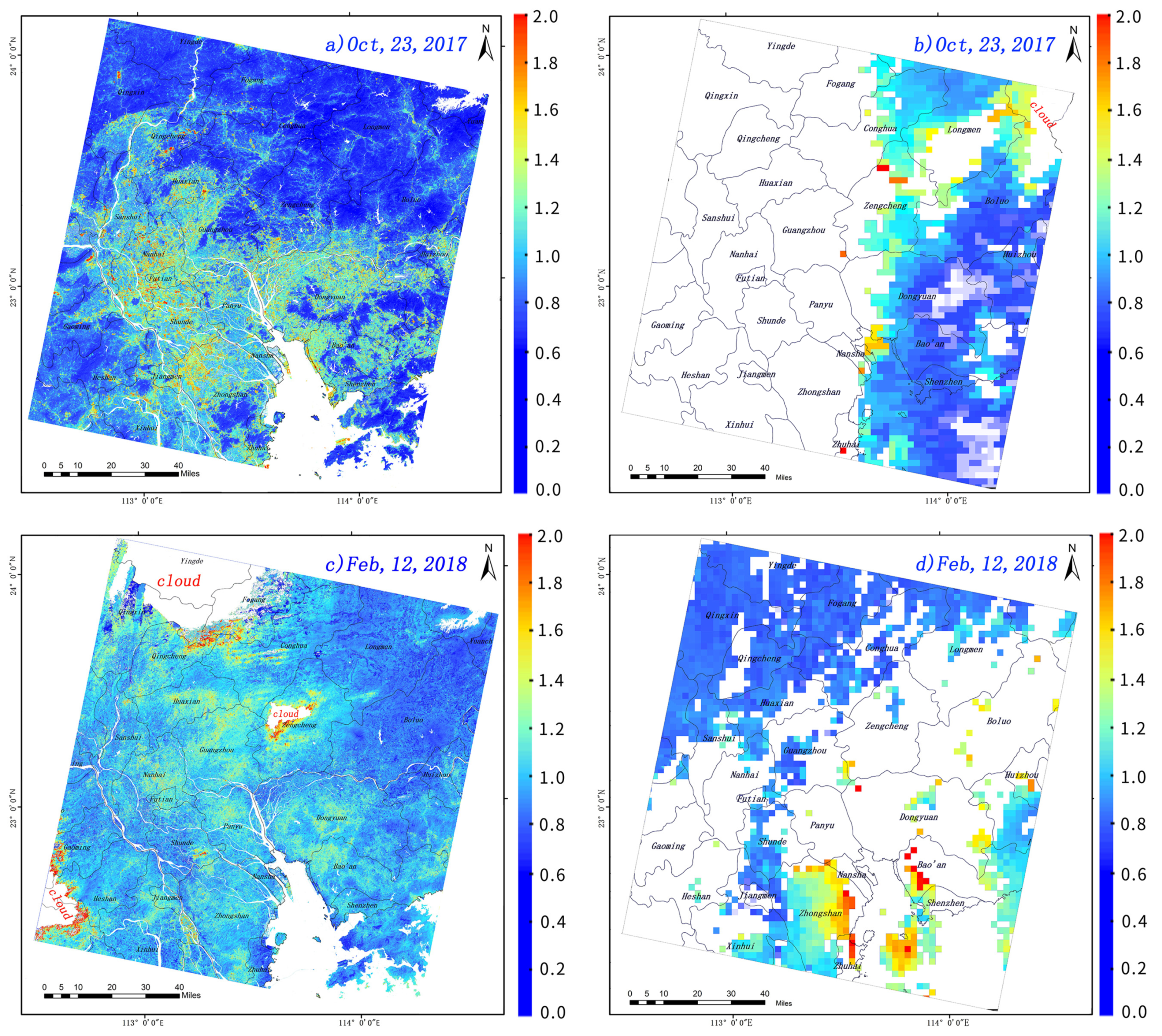
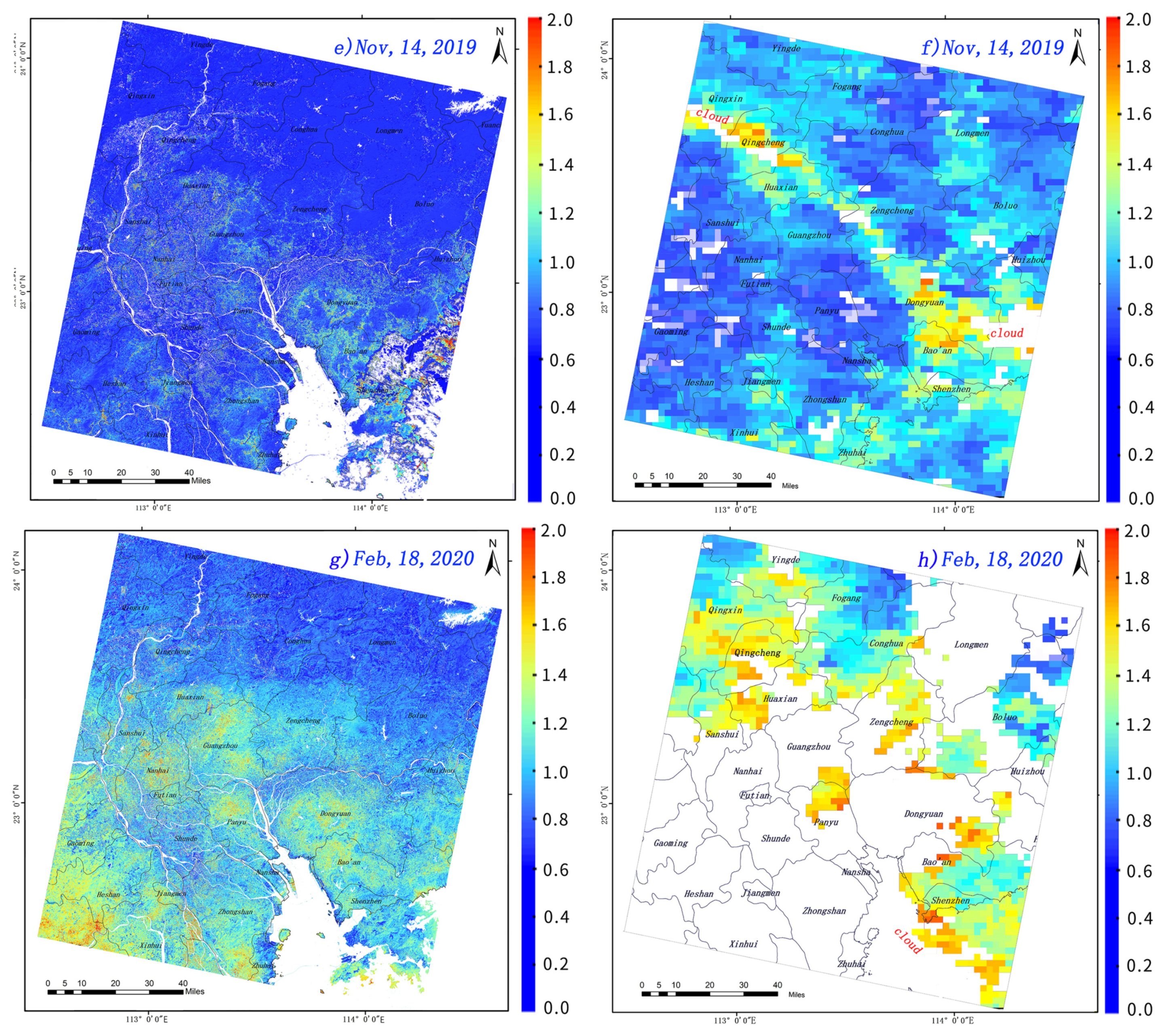



| Category | Product | Instrument | Time | Source |
|---|---|---|---|---|
| Image data | Landsat8 OLI image | Landsat8 OLI sensor | 23 October 2017 | USGS |
| 12 February 2018 | ||||
| Landsat8 OLI reflectance product | 14 November 2019 | |||
| 18 February 2020 | ||||
| Meteorological data | Relative humidity | Humidity sensor | Same as above | CEMS |
| Planetary boundary layer height | Lidar | Same as above | ECMWF | |
| Ground station data | PM2.5 mass concentrations | Same as above | CEMS | |
| Aerosol model | CE-318 | 2017–2019 | ||
| MODO4 data | AOD | MODIS sensor | Same as above | |
| Geographic data | Industrial zones and roads data | Crawler technology | Same as above | Baidu map |
| Band | Band Range (μm) | Spatial Resolution (m) | Round Trip Period (Days) | Swath (km) |
|---|---|---|---|---|
| Coast | 0.43–0.45 | 30 | 16 | 185 |
| Blue | 0.45–0.51 | |||
| Green | 0.53–0.59 | |||
| Red | 0.64–0.67 |
| Seasons | The Volume Ratio of Various Aerosol Particles Component/% | Average Concentrations by Volume (µm3 × µm−2) | |||
|---|---|---|---|---|---|
| Water-Soluble | Dust | Marine | Soot | ||
| Spring | 48.49 | 14.89 | 7.92 | 28.61 | 0.65 |
| Summer | 48.26 | 18.48 | 5.00 | 28.26 | 0.38 |
| Autumn | 47.20 | 17.17 | 7.56 | 28.07 | 0.47 |
| Winter | 49.85 | 12.20 | 9.49 | 28.46 | 0.49 |
| Input Parameters | Number of Entries | Entries |
|---|---|---|
| 15 | 0,6,12,…,84 | |
| 15 | 0,6,12,…,84 | |
| 16 | 0,12,24,…,180 | |
| AOD | 9 | 0,0.1,0.3,0.5,0.7, 1.0,1.2,1.5,2.0 |
| Atmospheric model | 2 | Mid-latitude summer/winter |
| Band | 4 | Coast, Blue, Green, Red |
| Parameters | Water-Soluble | Dust | Marine | Soot |
|---|---|---|---|---|
| (μm) | 0.176 | 17.60 | 3.80 | 0.05 |
| 1.090 | 1.090 | 0.920 | 0.693 |
| Error (%) | ||||||||
|---|---|---|---|---|---|---|---|---|
| Continental | 0.99 | 0.16 | 0.98 | 0.47 | urban | 0.85 | 0.50 | 11 |
| Normal | 0.97 | 0.23 | 0.81 | 0.86 | Mixed | 0.81 | 0.66 | 12 |
| Maritime | 0.93 | 0.29 | 0.81 | 0.86 | Marine | 0.67 | 0.83 | 50 |
| Average | 0.96 | 0.23 | 0.90 | 0.67 | Average | 0.78 | 0.66 | 24 |
Publisher’s Note: MDPI stays neutral with regard to jurisdictional claims in published maps and institutional affiliations. |
© 2021 by the authors. Licensee MDPI, Basel, Switzerland. This article is an open access article distributed under the terms and conditions of the Creative Commons Attribution (CC BY) license (https://creativecommons.org/licenses/by/4.0/).
Share and Cite
Tang, Y.; Deng, R.; Li, J.; Liang, Y.; Xiong, L.; Liu, Y.; Zhang, R.; Hua, Z. Estimation of Ultrahigh Resolution PM2.5 Mass Concentrations Based on Mie Scattering Theory by Using Landsat8 OLI Images over Pearl River Delta. Remote Sens. 2021, 13, 2463. https://doi.org/10.3390/rs13132463
Tang Y, Deng R, Li J, Liang Y, Xiong L, Liu Y, Zhang R, Hua Z. Estimation of Ultrahigh Resolution PM2.5 Mass Concentrations Based on Mie Scattering Theory by Using Landsat8 OLI Images over Pearl River Delta. Remote Sensing. 2021; 13(13):2463. https://doi.org/10.3390/rs13132463
Chicago/Turabian StyleTang, Yuming, Ruru Deng, Jun Li, Yeheng Liang, Longhai Xiong, Yongming Liu, Ruihao Zhang, and Zhenqun Hua. 2021. "Estimation of Ultrahigh Resolution PM2.5 Mass Concentrations Based on Mie Scattering Theory by Using Landsat8 OLI Images over Pearl River Delta" Remote Sensing 13, no. 13: 2463. https://doi.org/10.3390/rs13132463
APA StyleTang, Y., Deng, R., Li, J., Liang, Y., Xiong, L., Liu, Y., Zhang, R., & Hua, Z. (2021). Estimation of Ultrahigh Resolution PM2.5 Mass Concentrations Based on Mie Scattering Theory by Using Landsat8 OLI Images over Pearl River Delta. Remote Sensing, 13(13), 2463. https://doi.org/10.3390/rs13132463








